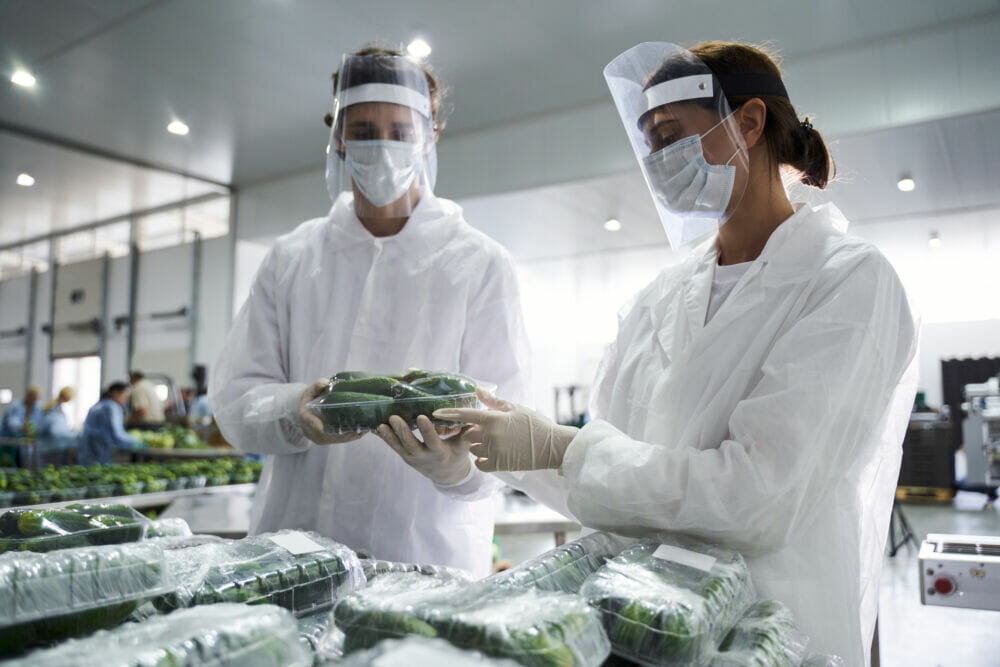You’ve heard of Six Sigma. And probably the five principles of waste management. Now, food contamination detection specialist Fortress Technology Europe has created a new acronym – the 7 R’s that are propelling food manufacturers towards implementing both metal detection and x-ray on processing lines. Retailers: Risk: Reporting: Recalls: Room: Reshoring and ROI!
Previously, metal detection and x-ray innovations were often pitted against each other. Yet, as food processors strive to curtail rising food prices through widespread adoption of automation and sourcing ingredients through different suppliers, the contamination risks have risen incrementally. The threat posed by a recall and enhanced quality control is certainly driving wider adoption of both x-ray and metal detection.
Comparing the performance of the company’s award winning Raptor x-ray side-by-side with the Interceptor metal detector at PPMA 2021, Managing Director of Fortress Technology Europe Phil Brown ran a demo outlining the respective strengths and limitations of each system. Notably, this showcase revealed each technology individually picked up 75 percent of potentially harmful and brand damaging contaminants. Yet, when combined the complementary systems reliably caught 100 percent.
Phil recaps on the seven R’s that are driving food factories to implement a more robust ‘best in class’ contaminant detection strategy:
1.RETAILER REQUIREMENTS
Intensifying competition in retail markets is seeing food producers stepping up their game to protect brands. Buoyed by market demand, online sales and under pressure to keep retail shelves stocked throughout the pandemic, many processors have subsequently ramped up their investments in new production and packaging lines.
No line is complete without quality control and most of the major retailers now require food suppliers to demonstrate that they are identifying all contaminants, including metal, glass, wood, rubber, high density plastic, stone and calcified bones. Rather than considering both technologies independently, some retailers now insist on this more collaborative approach to contaminant detection.
Phil expands: “The decision to invest in x-ray or metal detection equipment is dependent upon a manufacturer’s requirements. Both technologies come with their own advantages; neither should be a replacement for good manufacturing practices, but rather food safety units should complement the process based on needs and risks.
“Flexing to the demands of the pandemic has amplified awareness of food safety. Suddenly inundated with click-and-collect orders and home deliveries, retailers had to adapt rapidly, placing even greater pressures on the chain of custody and e-fulfillment infrastructures. It also required renewed adherence to food safety best practices and inspection protocols.”
2. RISKS
The most common contamination culprits are metal, for example fragments that break off during mechanical cutting and blending operations, glass from storage or packaging, and hard plastics introduced by fatigued tools and equipment.[1]
Each sector has its own set of more prevalent risks. With convenience meals, there can be more than eight production steps between sourcing ingredients to packing, and more than five different product types included in an individual meal. This increases the risk of metal and plastic contaminations. Intrinsic contaminants are common in protein ingredients, such as bones or teeth from fish, meat and poultry. They can also occur in fresh produce, for example fruit and vegetable pips or egg shells.
Additionally, there are human risks. Use of PPE since the start of the pandemic has naturally augmented these contamination risks on food processing lines. Putting this into context, Phil suggests that a factory with 200 food operatives, each wearing at least two items of PPE daily – a hairnet and mask – has created 146,000 potential contaminants annually. Most of these are metal detectable.
Phil expands: “An x-ray machine is a density detection system and will therefore identify denser contaminants like glass, ceramic and bone. However, as we demonstrated at PPMA, there are certain metals it can’t detect in a food product. Lightweight foil strips in PPE is a good example. Although visible to a metal detector, in contrast there’s not enough density differential between the foil contaminant and the product being inspected for an x-ray to pick this up.”


3. REPORTING
Collating live OEE data and reporting results directly to QA and technical personnel is increasingly imperative in fast-moving food production lines. For traceability and audit purposes, records must be kept in order to verify that each system is performing to UK retailer COP standards and to prove that inspection procedures are being followed consistently and correctly. Additionally, unannounced or virtual audits mean that documentation needs to be readily available at all times.
Advanced software, uniquely available on both the Fortress Raptor X-ray and Interceptor Metal Detector, enables fast, reliable and easy product set up and reporting. Both systems automatically pre-programme every UK retailer COP that exists into the machine menu. These standards stipulate what type of inspection system should be used, how it should ensure rejected products are removed from the line, how the system should ‘fail safely’ and target sensitivities for different metal detector and x-ray aperture sizes.
Production operatives simply select the retailer and product being inspected on the HMI home screen, run a calibration and QA test, pass the test packs through, confirm rejection and remove from the reject bin. Once passed a report is instantly dispatched from the HMI. With the new Raptor X-ray these can be performed over the company network and sent directly to the technical manager’s inbox. In less than a minute, a new product application is ready to run.
With audits becoming increasingly virtual during the pandemic, this seamless digital process verifies that any regular contaminant test or product reset process is followed to the absolute letter, clarifies Phil. “It’s a failsafe and fully auditable test and product re-calibration system.”
4. RECALLS
Any food recall incident is a crisis situation that requires quick action to mitigate longstanding financial and reputational damage. However, QA often runs deeper than the obvious. Rather than considering the ‘if’ it can be prudent to think instead about the ‘when’.
Future contaminant risks means you are not looking for patterns but future potential holes in the security chain, for example the increased risks from PPE, highlights Phil. From a practical perspective, food processing inspection risks should be reviewed every 12 months as part of a defined HACCP assessment.
Supply chain transparency and the speed in which you can publicly pinpoint the source of a contaminant is imperative and can minimise any damage to brand reputation. Reporting software facilitates this traceability, demonstrates due diligence and helps to narrow the time frame in which a problem may go undetected.
5. ROOM
Factory space is at a premium and the ever-increasing cost of real estate means each cubic metre has to be maximised. One of the easiest ways to save line space and improve cost of ownership is to opt for a combined system. Mounting these systems on the same conveyor results in a far smaller footprint than stand-alone units would occupy.
Being a single OEM for every inspection need, Fortress is paving the way towards even greater production integration and data-driven capabilities. It’s even feasible states Phil to deploy x-ray in tandem with metal providing a holistic solution in a smaller footprint. The X-ray would pick up stainless steel and ferrous metal contaminants as well as glass, stones and other non-metallic particles, whilst the metal detector would find foil.
“We recently took this concept a stage further incorporating dual density software into a compact Raptor Metal Detector/X-ray combi system. Operating side by side, the two inspection heads are mounted on one conveyor and operated by a single touchscreen, sharing electronics, controls and a reject mechanism. Giving the best performance across the full contaminant spectrum,” states Phil. Clever configuration of a shared reject mechanism, HMI and conveyor can save 50 per cent in space compared to two machines operating independently.
6. RESHORING REVERSAL
Today’s food manufacturing world is in a very different place to how it was 20 years, and indeed 20 months ago. With the pandemic highlighting the fragility of international supply chains, Phil has observed a definite shift in attitudes towards reshoring and a steady increase in live enquiries for food-grade x-ray and metal detection solutions with British food factories seeking a swift turnaround.
“Even before Brexit, the weak pound and ongoing tariff negotiations prompted many UK food manufacturers to price up their import versus domestic sourcing options. A number made the conscious and pragmatic decision to source their food safety equipment domestically citing the need for greater resilience and proximity to the engineering support team,” notes Phil.
“Our close vicinity to customers means we can flex and scale production up and down to meet demand. Apart from several electronic parts, all of our machinery components are designed and made within the UK,” Phil adds.
7. ROI
A key cog in any food processor’s business is the performance and efficiency of production equipment. A common error when calculating ROI is overlooking running costs and factoring in more subtle costs such as interruption to production, machine testing, training and support. These all form part of the pay back equation.
It’s why Fortress designed the Raptor X-ray to minimise energy consumption. Whereas some food x-ray machines require cooling systems, such as fans or air conditioners, the Raptor X-ray pulls in fresh air and uses a more energy efficient fan generator to circulate air through the cabinet.
With filaments in an x-ray tube running hotter when more current is demanded, the Raptor typically runs at half voltage – 80kV. This helps to prevent overheating, maintains a steady cabinet ambient temperature of 30° and helps to extend the service life of the tubes.
A similar ethos is applied to Fortress metal detectors. Designed with modularity and scalability in mind, all Fortress metal detectors can have its software upgraded ensuring full compliance with HACCP and COPs. Additionally, the electronic boards are interchangeable, which means customers can hold just one spare in stock. Or they can simply swap a board out from another machine while waiting for a replacement to be delivered. Thus, minimising downtime.
Phil concludes: “Every technology advancement helps to build a safer food environment for all, protecting consumers and suppliers. Previously, it might have been harder to justify the cost of having both x-ray and metal detection on a single line. However, as our demonstration clearly showcases, even the best systems are not infallible.
“There are way more than seven reasons for implementing complementary technology. Yet, with the advancement in affordable inspection machines, food manufacturers no longer need to substitute one for the other. Having both is more than feasible and helps to safeguard against more harmful and brand damaging contaminants slipping through the net.”





